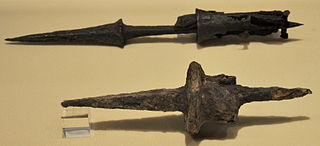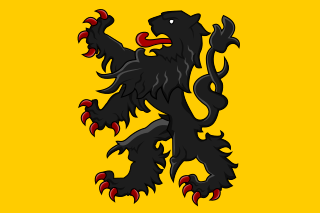
Flanders is the Dutch-speaking northern portion of Belgium and one of the communities, regions and language areas of Belgium. However, there are several overlapping definitions, including ones related to culture, language, politics, and history, and sometimes involving neighbouring countries. The demonym associated with Flanders is Fleming, while the corresponding adjective is Flemish, which can also refer to the collective of Dutch dialects spoken in that area, or more generally the Belgian variant of Standard Dutch. The official capital of Flanders is the City of Brussels, although the Brussels-Capital Region that includes it has an independent regional government. The powers of the government of Flanders consist, among others, of economic affairs in the Flemish Region and the community aspects of Flanders life in Brussels, such as Flemish culture and education.

The Battle of the Golden Spurs or 1302 Battle of Courtrai was a military confrontation between the royal army of France and rebellious forces of the County of Flanders on 11 July 1302 during the 1297–1305 Franco-Flemish War. It took place near the town of Kortrijk in modern-day Belgium and resulted in an unexpected victory for the Flemish.

"De Vlaamse Leeuw" is the official anthem of Flanders, a region and community in Belgium.

Henri (Hendrik) Conscience was a Belgian author. He is considered the pioneer of Dutch-language literature in Flanders, writing at a time when Belgium was dominated by the French language among the upper classes, in literature and government. Conscience fought as a Belgian revolutionary in 1830 and was a notable writer in the Romanticist style popular in the early 19th century. He is best known for his romantic nationalist novel, The Lion of Flanders (1838), inspired by the victory of a Flemish peasant militia over French knights at the 1302 Battle of the Golden Spurs during the Franco-Flemish War.
John II was Count of Hainaut, Holland, and Zeeland.

A goedendag was a weapon originally used by the militias of Medieval Flanders in the 14th century, notably during the Franco-Flemish War. The goedendag was essentially a combination of a club with a spear. Its body was a wooden staff roughly 90 cm to 150 cm long with a diameter of roughly 5 cm to 10 cm. It was wider at one end, and at this end a sharp metal spike was inserted by a tang.

Pieter de Coninck was a weaver from Bruges well known for his role in the events surrounding the Battle of the Golden Spurs. He was not the head of the weavers' guild as is popularly believed. Together with Jan Breydel, a butcher, he was in the forefront of the popular uprising that led to the Battle of the Golden Spurs. Right before that battle he was knighted together with two of his sons.

Jan Breydel is credited with leading the Bruges Matins, a violent uprising against Philip the Fair. He is said to have played a major role in the Franco-Flemish War, even though his authenticity has since been questioned.

The Matins of Bruges was the nocturnal massacre of the French garrison in Bruges and their Leliaards supporters, a political faction in favour of French rule, on 18 May 1302 by the members of the local Flemish militia. It has been named "Matins" in analogy to the Sicilian Vespers of 1282. The revolt led to the Battle of the Golden Spurs, which saw the Flemish militia defeat French troops on 11 July 1302.
The coat of arms of the Flemish Community is a heraldic symbol used by Flanders, Belgium. Although the lion has been in use for almost nine hundred years as the arms of the Count of Flanders, it only became the official symbol of the Flemish Community in 1973. At present its form and use is subject to the Decree of 7 November 1990.

Kortrijk, sometimes known in English as Courtrai or Courtray, is a Belgian city and municipality in the Flemish province of West Flanders.

Flemish people or Flemings are a Germanic ethnic group native to Flanders, Belgium, who speak Flemish Dutch. Flemish people make up the majority of Belgians, at about 60%.

The Courtrai Chest is a oak chest which incorporates Medieval carvings depicting scenes from the Franco-Flemish War and, in particular, the Battle of the Golden Spurs at Kortrijk (Courtrai) in Flanders. The chest is among the few surviving contemporaneous depictions of those historically-significant events.

The history of Flanders concerns not only the modern Dutch-speaking part of Belgium, which is now called "Flanders", but also several neighbouring territories and populations. Its historical core territory was in western Belgium between the coast and the Scheldt river.

On 23 August 1328, the Battle of Cassel took place near the city of Cassel, 30 km south of Dunkirk in present-day France. Philip VI fought Nicolaas Zannekin, a wealthy farmer from Lampernisse. Zannekin was the leader of a band of Flemish rebels. The fighting erupted over taxation and punitive edicts of the French over the Flemish. The battle was won decisively by the French. Zannekin and about 3,200 Flemish rebels were killed in the battle.

The Lion of Flanders, or the Battle of the Golden Spurs is a major novel first published in 1838 by the Belgian writer Hendrik Conscience (1812–1883)—an early example of historical fiction. The book focuses on the medieval Franco-Flemish War and the Battle of the Golden Spurs of 1302 in particular. It is written in Conscience's typical stylistic romanticism and has been described as the "Flemish national epic".

The Franco-Flemish War was a conflict between the Kingdom of France and the County of Flanders between 1297 and 1305.

Bruges is the capital and largest city of the province of West Flanders in the Flemish Region of Belgium, in the northwest of the country. It is the sixth most populous city in the country.

The County of Flanders was one of the most powerful political entities in the medieval Low Countries, located on the North Sea coast of what is now Belgium. Unlike its neighbours, such as the counties of Brabant and Hainaut, it was within the territory of the Kingdom of France. The counts of Flanders held the most northerly part of the kingdom, and were among the original twelve peers of France. For centuries, the economic activity of the Flemish cities, such as Ghent, Bruges and Ypres, made Flanders one of the most affluent regions in Europe, and also gave them strong international connections to trading partners.

Willem van Saeftinghe was a lay brother in the Cistercian abbey of Ter Doest in Lissewege, West Flanders, Belgium. He fought at the Battle of the Golden Spurs, and became a Flemish folk hero.



















